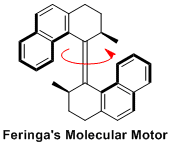Chen, K.-Y.; Ivashenko, O.; Carroll, G. T.; Robertus, J.; Kistemaker, J. C. M.; London, G.; Browne, W. R.; Rudolf, P.; Feringa, B. L. J. Am. Chem. Soc. 2014. 136, 3219–3224.
DOI: 10.1021/ja412110t
Monolayers of fluorinated light-driven molecular motors were synthesized and immobilized on gold films in an altitudinal orientation via tripodal stators. In this design the functionalized molecular motors are not interfering and preserve their rotary function on gold. The wettability of the self-assembled monolayers can be modulated by UV irradiation.
Recently, an interesting paper was reported from the Pro Ben. L. Feringa In Groningen university. He is a famous chemist for establishing molecular machines, which can rotate uniformly in single direction using light-radiation and heat.[1] Based on this molecular design, Feringa and co-workers succeeded in controlling the wettability of waterdrop on thin gold layer with only one layer of the molecule machine coated, that is 1.6 nm in height from the surface. Although there are lot of similar work in hope of controlling wettability using light irradiation, group of Feringa was the first one to achieve this using single layer of molecule.
Although there are still a lot thing to be improved, such as reversible and more efficient switching, avoid using UV and stronger wettability, this is the fundamental research for material science at molecular level.
Molecular design: Tripod was used to ensure that each molecule on surface are positioned uniformly and fix the rotating unit on the desired spatial position. Perfluorobutyl group, which is highly water proof, is directly attached to rotation unit to maximize the reversible changing of the wettability.
- References
[1] (a) “Making molecular machines work”
Browne, W. R.; Feringa, B. L. Nat. Nanotechnol. 2006, 1, 25−35. DOI: 10.1038/nnano.2006.45
In this review we chart recent advances in what is at once an old and very new field of endeavour — the achievement of control of motion at the molecular level including solid-state and surface-mounted rotors, and its natural progression to the development of synthetic molecular machines. Besides a discussion of design principles used to control linear and rotary motion in such molecular systems, this review will address the advances towards the construction of synthetic machines that can perform useful functions. Approaches taken by several research groups to construct wholly synthetic molecular machines and devices are compared. This will be illustrated with molecular rotors, elevators, valves, transporters, muscles and other motor functions used to develop smart materials. The demonstration of molecular machinery is highlighted through recent examples of systems capable of effecting macroscopic movement through concerted molecular motion. Several approaches to illustrate how molecular motor systems have been used to accomplish work are discussed. We will conclude with prospects for future developments in this exciting field of nanotechnology.
(b) “Reversible Photocontrol of Biological Systems by the Incorporation of Molecular Photoswitches”
Szymanski, W.; Beierle, J. M.; Kistemaker, H. A. V.; Velema, W. A.; Feringa, B. L. Chem. Rev. 2013, 113, 6114−6178. DOI: 10.1021/cr300179f
- Related Book
[amazonjs asin=”3527305947″ locale=”US” title=”Molecular Motors”]
- Related Links
The Feringa Group
Interview with Ben Feringa
Synthetic Molecular Motor - Wikipedia



